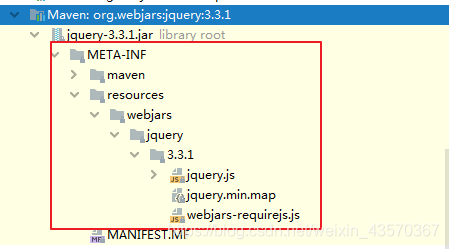写在前面:最近利用晚上的时间在网上看视频学习Spring Boot,这博客是对学习的一点点总结及记录,技术是开源的、知识是共享的。
如果你对Spring Boot 感兴趣,可以关注我的动态,我们一起学习。用知识改变命运,让家人过上更好的生活。
一、springmvc 对静态资源的映射规则
<!-- 设置静态资源不过滤 -->
<mvc:resources location="/css/" mapping="/css/**" />
<mvc:resources location="/images/" mapping="/images/**" />
<mvc:resources location="/js/" mapping="/js/**" />
二、SpringBoot对静态资源的映射规则
1. 默认静态资源位置
1.1 所有 /webjars/** ,都去 classpath:/META-INF/resources/webjars/ 找资源;
注意: 在访问的时候只需要写webjars下面资源的名称即可
webjars:以jar包的方式引入静态资源,在pom文件中引入依赖:
<!-- 引入jquery的webjar -->
<dependency>
<groupId>org.webjars</groupId>
<artifactId>jquery</artifactId>
<version>3.3.1</version>
</dependency>

1.2 “/**” 访问当前项目的任何资源,都去(静态资源的文件夹)找映射
先看其源码:
@Override
public void addResourceHandlers(ResourceHandlerRegistry registry) {
if (!this.resourceProperties.isAddMappings()) {
logger.debug("Default resource handling disabled");
return;
}
Duration cachePeriod = this.resourceProperties.getCache().getPeriod();
CacheControl cacheControl = this.resourceProperties.getCache().getCachecontrol().toHttpCacheControl();
if (!registry.hasMappingForPattern("/webjars/**")) {
customizeResourceHandlerRegistration(registry.addResourceHandler("/webjars/**")
.addResourceLocations("classpath:/META-INF/resources/webjars/")
.setCachePeriod(getSeconds(cachePeriod)).setCacheControl(cacheControl));
}
String staticPathPattern = this.mvcProperties.getStaticPathPattern();
if (!registry.hasMappingForPattern(staticPathPattern)) {
customizeResourceHandlerRegistration(registry.addResourceHandler(staticPathPattern)
.addResourceLocations(getResourceLocations(this.resourceProperties.getStaticLocations()))
.setCachePeriod(getSeconds(cachePeriod)).setCacheControl(cacheControl));
}
}

ResourceProperties.java
@ConfigurationProperties(prefix = "spring.resources", ignoreUnknownFields = false)
public class ResourceProperties {
private static final String[] CLASSPATH_RESOURCE_LOCATIONS = { "classpath:/META-INF/resources/",
"classpath:/resources/", "classpath:/static/", "classpath:/public/" };
从源码可以得出访问路径:
"classpath:/META‐INF/resources/",
"classpath:/resources/",
"classpath:/static/",
"classpath:/public/"
"/":当前项目的根路径
前面4个是resource目录下的不同目录
注意:最后一个 / 就是表示 webapp 目录中的静态资源也不被拦截。这个不经常使用。
idea中创建好Spring Boot项目,默认的目录就有static

如果要访问static下面的hello.jpg ,在浏览器输入
http://localhost:8080/hello.png 就可以去静态资源文件夹里面找hello.jpg
1.3 访问欢迎页; 静态资源文件夹下的所有index.html页面;被"/**"映射;

1.4 配置需要的图标,所有的 **/favicon.ico 都是在静态资源文件下找;
2. 自定义配置
第一种: 在Springboot中可以直接在配置文件中覆盖默认的静态资源路径的配置信息:
#配置定义的资源位置
spring.resources.static-locations=classpath:/
#配置定义的请求url规则
spring.mvc.static-path-pattern=/**
第二种: 在SpringBoot开发中,可以在Java代码中覆盖默认静态资源配置
@Configuration
public class WebMvcConfig extends WebMvcConfigurerAdapter {
@Override
public void addResourceHandlers(ResourceHandlerRegistry registry) {
if(!registry.hasMappingForPattern("/static/**")){
registry.addResourceHandler("/static/**").addResourceLocations("classpath:/static/");
}
super.addResourceHandlers(registry);
}
}
